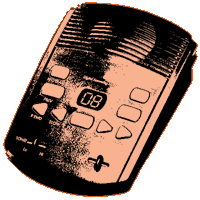Jul 28
 Dial-up Internet Access: Dial-up connections have fallen from 40% in 2001 to 10% in 2008. The combination of an infrastructure to accommodate affordable high speed Internet connections and the disappearing home phone have all but pounded the final nail in the coffin of dial-up Internet access.
Dial-up Internet Access: Dial-up connections have fallen from 40% in 2001 to 10% in 2008. The combination of an infrastructure to accommodate affordable high speed Internet connections and the disappearing home phone have all but pounded the final nail in the coffin of dial-up Internet access. - Movie Rental Stores: While Netflix is looking up at the moment, Blockbuster keeps closing store locations by the hundreds. It still has about 6,000 left across the world, but those keep dwindling and the stock is down considerably in 2008, especially since the company gave up a quest of
Circuit City. Movie Gallery, which owned the Hollywood Video brand, closed up shop earlier this year. Countless small video chains and mom-and-pop stores have given up the ghost already. - Classified Ads: The Internet has made so many things obsolete that newspaper classified ads might sound like just another trivial item on a long list. But this is one of those harbingers of the future that could signal the end of civilization as we know it. The argument is that if newspaper classifieds are replaced by free online listings at sites like Craigslist.org and Google Base, then newspapers are not far behind them.
- Yellow Pages: This year will be pivotal for the global Yellow Pages industry. Much like newspapers, print Yellow Pages will continue to bleed dollars to their various digital counterparts, from Internet Yellow Pages (IYPs), to local search engines and combination search/listing services like ReachLocal and Yodle. Factors like an acceleration of the print “fade rate” and the looming recession will contribute to the onslaught. One research firm predicts the falloff in usage of newspapers and print Yellow Pages could even reach 10% this year — much higher than the 2%-3% fade rate seen in past years.
- Answering Machines: The increasing disappearance of answering machines is directly tied to the decline of landlines. According to USA Today, the number of homes that only use cell phones jumped 159% between 2004 and 2007. It has been particularly bad in
New York; since 2000, landline usage has dropped 55%. It’s logical that as cell phones rise, many of them replacing traditional landlines, that there will be fewer answering machines. - Cameras That Use Film: It doesn’t require a statistician to prove the rapid disappearance of the film camera in
America. Just look to companies like Nikon, the professional’s choice for quality camera equipment. In 2006, it announced that it would stop making film cameras, pointing to the shrinking market — only 3% of its sales in 2005, compared to 75% of sales from digital cameras and equipment. - Stand-Alone Bowling Alleys: BowlingBalls.US claims there are still 60 million Americans who bowl at least once a year, but many are not bowling in stand-alone bowling alleys. Today most new bowling alleys are part of facilities for all types or recreation including laser tag, go-karts, bumper cars, video game arcades, climbing walls and glow miniature golf. Bowling lanes also have been added to many non-traditional venues such as adult communities, hotels and resorts, and gambling casinos.
- Hand-Written Letters: In 2006, the Radicati Group estimated that, worldwide, 183 billion e-mails were sent each day. Two million each second. By November of 2007, an estimated 3.3 billion Earthlings owned cell phones, and 80% of the world’s population had access to cell phone coverage. In 2004, half-a-trillion text messages were sent, and the number has no doubt increased exponentially since then. So where amongst this gorge of gabble is there room for the elegant, polite hand-written letter?
- Drive-in Theaters: During the peak in 1958, there were more than 4,000 drive-in theaters in this country, but in 2007 only 405 drive-ins were still operating. Exactly zero new drive-ins have been built since 2005. Only one reopened in 2005 and five reopened in 2006, so there isn’t much of a movement toward reviving the closed ones.
- Analog TV: According to the Consumer Electronics Association, 85% of homes in the
U.S. get their television programming through cable or satellite providers. For the remaining 15% — or 13 million individuals — who are using rabbit ears or a large outdoor antenna to get their local stations, change is in the air. If you are one of these people you’ll need to get a new TV or a converter box in order to get the new stations which will only be broadcast in digital.
courtesy of Consumerist
Recent Comments